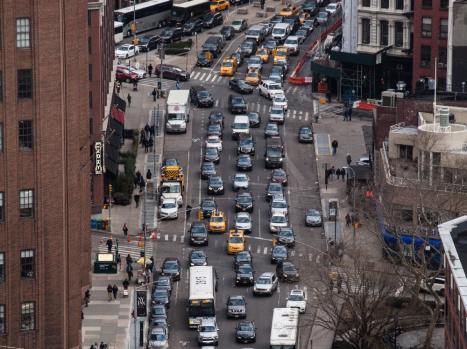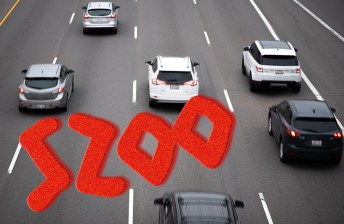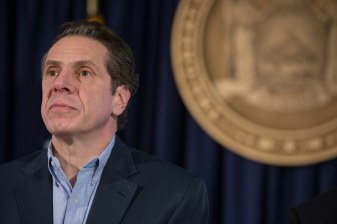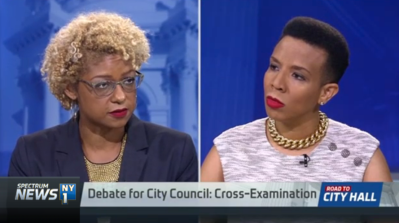In Their Own Words: New Yorkers Want Congestion Pricing … And Now

Hi, can you hear me?
The people of New York were finally able on Thursday to tell the federal government what they wanted — congestion pricing — with an overwhelming number of attendees at the first (and virtual) public meetings on the traffic toll’s environmental assessment telling the transportation officials that it was finally time to get this thing going.
Per my scorecard, kept by a person who watched five hours of live pro wrestling last night, it was a rout for the people asking for congestion pricing. I might be off by one or two, so please don’t print this photo in the newspaper pic.twitter.com/2mBOoDtJ76
— Good Idea Dave (@DaveCoIon) September 23, 2021
Both the morning and evening sessions were not without massive ironies: Several speakers at the first “outer borough” comment session complained that charging non-Manhattan drivers a toll is “elitist” because the benefits — in terms of quality of life and reduced pollution — will only go to wealthy Manhattanites. Meanwhile, at the evening session devoted to Manhattanites’ issues, many car owners said the tolls would be an unfair burden on them and that they did not want to pay … for the benefits that most of them admit they would enjoy.
And Manhattanites who live below 61st Street are among the richest people on the planet. Those who live below 61st Street and own a car are the kind of people who are more likely to ride with Jeff Bezos into space than ride the 5 train.
Most speakers supported the tolling scheme. Some said they were opposed. And everyone started speaking by first saying, “Can you hear me now?” — a symptom of the Zoom/YouTube/livestream format. Here are the best comments we heard:
We’ve already waited too long
Can you believe that over two years after the state legislature passed congestion pricing, we’re only just now studying how to maybe actually implement it? In the meantime, buses are stuck in traffic and New Yorkers are suffering Gridlock Alert Day after Gridlock Alert Day. And yet here we are, facing down another 16 months of study before maybe getting this whole thing rolling by 2023.
Buses are at a crawl. Hundreds of thousands of people rely on our bus system that is absolutely choked in traffic, day in, day out. Every single day, the actual residents of New York City are, are being forced to sit in car traffic that they simply can’t avoid. I think that a 2023 date for the implementation of this is beyond too long. The Central Business District tolling program should have gone into place five years ago, three years ago, two years ago, last year, yesterday. I encourage everyone involved to get this project and implement it as soon as possible.
Alex Weinberg
Your car commute is killing us
Unhealthy air quality days are becoming a regular occurrence during New York summers. Additionally, it’s been a deadly year on city streets, with the most recent example coming by way of an out of control driver who mowed down three-month old Apolline Mong-Guillemin earlier this month. Even before that, the city witnessed almost 30 cyclist fatalities in 2019 and pedestrians and cyclists seem under siege by the increasing amount of drivers getting away with speeding and reckless driving across the city. It’s time to try to keep people alive, with fewer cars and cleaner air.
Like many other Americans. I grew up in a really polluted area, and as a child, I developed asthma. It was debilitating, as a child. One year I missed 25 days of school because of asthma. And this dynamic plays out thousands of times across the country. And it is a choice — a choice — that we continue to allow our air to be polluted. As I have returned commuting to Manhattan I have encountered more and more idling cars as the traffic volume has gone up, both in Manhattan, and on the bridges waiting to go into Manhattan. And I just would urge the MTA to implement this policy as quickly as possible to address this air quality crisis in the city today.
Patrick Harrel
Cars are a scourge in New York City. New Yorkers cannot hear ourselves think with all the noise cars create, we cannot breathe the air without damaging our lungs. We can’t even safely cross the street because of the threat of the automobile in our city. This leads to a few questions. Why do we allow us to do some environmentally harmful instruments to come into the densest part of our city without any limits or restrictions. Why do we allow drivers to externalize all of the costs their transportation mode incurs on everyone, while they enjoy all the benefits. This isn’t a sustainable model of transportation, and the gridlock we’re witnessing in Manhattan proves it. There is a better way. You can internalize the cost of driving by charging a fee to enter the CBD, we can put a price on driving so individuals who engage in this harmful act, have to reconsider whether they truly need to get in their cars. We can use money generated by the program to fund capital projects for the MTA and improve public transportation for everybody, which will make New York a cleaner, more equitable city, they’ll become a model of transportation justice for the entire country.
Thomas Huzij
As a resident [of Manhattan] we are constantly bombarded with endless amounts of traffic, our health and well being is impacted by excessive amounts of cars on the streets, particularly vehicles that are here, and parking illegally, I might add with an extended amount of placard abuse happening in this neighborhood. Unlike other residents of the east side, I don’t want there to be a carve out. I own a vehicle, but I believe that we should all be responsible for the choices that we make, and that the extensive carve outs that are being requested are again going to reduce the effectiveness of congestion pricing, reduce the amount of income streams, and also fail to adequately reduce the impact of cars on our streets
Rachel T
Drivers are becoming increasingly unhinged. This is the deadliest year on our streets in some time. Drivers speed and run red lights, causing death, injury and disability in numbers that should shock everyone. They also park on the sidewalk, and in the bike lane, in the bus lane. And cars are noisy, they disturb the peace, spew fumes that cause asthma, and they clog our streets, slowing down ambulances and fire trucks as they respond to emergencies. Cars make life worse for New Yorkers and everything we can do to reduce driving will improve life here. Moreover, if we reduce the number of people driving into the city, we can repurpose some of the space currently dedicated to cars, and we can have more sidewalks and more trees and grass. It is a win-win.
MacKeznie Fillo
Even setting aside the issue of traffic violence New York has never been a city for driving. According to 2018 census estimates, the majority of NYC households did not own a car, including 60 percent of Bronx households, most of us therefore get around by subway, bus, walking or biking. Anyone who regularly uses these modes of transportation is aware that they’re all in need of increased funding and infrastructure, which will both be achieved through the revenue generated from the congestion pricing plan. The more we continue to cater to drivers in our city, the more our buses and emergency vehicles will continue to be slowed by traffic, and the more our transit system will continue to be plagued by delays and outdated systems. Some opponents of the plan have suggested that residents of the outer boroughs will be negatively impacted because they lack good transit options, but the answer to this problem is not to continue to rely on cars to fill the gaps in transit. The answer is to improve transit and reduce reliance on cars. Furthermore, given the climate crisis which disproportionately affects low income-communities. There is no excuse for continuing to allow so many cars to clog our streets and pollute our air
Sandra Voss
I love biking over to the city. But the thing is biking in New York City kind of sucks. Whenever I bike in lower Manhattan cars always get angry at me. I stay in the bike lane, I wear my helmet, I do all the stops. I am a very good cyclist, but cars are just violent towards me, and that’s something that I think we could change if we implement congestion pricing because driving makes you angry, especially when there’s traffic. And that kind of anger leads to road rage with traffic violence, and that hurts people. So, congestion pricing, I think is really necessary because I want to be able to bike to school I want to feel safe doing so and that is something that congestion pricing can help.
Alexa Jakob
Calling this area a “business district” is a gross mischaracterization. For us it is a living district, more than 1.3 million New Yorkers lives in this area and millions of others walk, bike or take transit to work and go to school here. We breathe the air here we raise our families here, we live our lives here. This is our community and our backyard, Like everyone we deserve and expect clean air quiet streets and safe and comfortable ways to get around. However, what we have with the status quo is hostility and aggression, noise and air pollution, and the constant physical and psychological threat of violence, thanks to unimpeded vehicle traffic on our streets. That has to end. Those who choose to drive into and through our neighborhoods, would likely never accept these same conditions in theirs. In fact, I imagine they would try to do something to fix it. And that’s what congestion pricing does it attempts to restore some balance to a broken, inequitable and unsustainable transportation system. And it addresses the needs of communities harmed by the status quo. Congestion pricing is a necessary and long overdue first step to giving my family and millions of our neighbors the same quality of life in our backyard, as others expect and deserve in theirs. I fully support congestion pricing and urge you to implement it in the fastest possible timeframe.
Carl Mahaney
This is how we build a more accessible subway
The MTA’s current capital plan, which is supposed to get almost thirty percent of its funding from congestion pricing, contains the most ambitious accessibility upgrades for the subway system in decades, with a plan to install elevators and accessibility upgrades in 70 stations across the system. It’s a plan that will unlock the trains for thousands more New Yorkers who have been forced to make do with a transit system that’s been outright hostile to their needs for decades.
I used to take the train everywhere, but a couple of months into the pandemic, I got a car, because I injured my knee, which meant climbing the stairs at my local station too painful and there isn’t a train station with reliable working elevator near my home. I miss taking the train, it used to be the easiest and fastest way for me to get around the city. And I want to start riding again, but a few things are stopping me. Train service is infrequent and unreliable, and I still have problems with the stairs. To make the subway efficient, reliable and accessible, the MTA needs money. Congestion pricing will give the MTA an ongoing source of revenue that it desperately needs to build and maintain subway stations and elevators and modernize the system. A reliable transit system also benefits my community by decreasing car congestion in the street, and air pollution in our neighborhood. It will also make it easier for me on the occasions that I need to drive into the city for a doctor’s appointment, as I won’t be in the gridlocked traffic for the past few months. I am happy to contribute my part whenever I drive into Manhattan, paying that fee will benefit me in the long run, and will also benefit my neighbors and all New Yorkers. So please take my money.
Sara Clugage
The outerboroughs want better transit
Congestion pricing isn’t simply a giant hole the city and state dig in which to dump the toll money. It will specifically fund projects like upgrading the subway’s ancient signal system on lines that serve huge swathes of the city, fund new trains and buy electric buses among plenty of steps to modernize the mass transit system. And while some speakers said that New Yorkers outside Manhattan were wedded to getting around with their cars for free forever, it’s clearly not the case.
I live in one of the outer boroughs that some of your commenters have been saying are going to be unfairly impacted by this congestion pricing toll. I just wanted to say that I completely disagree. And I think that folks in the outer boroughs are going to be really happy to have increased funding directed at transit, improving our buses and subways, you know, in my neighborhood in the Bronx, almost 90% of the residents do not drive to work. So when people say, comments such as, oh well this toll is going to unfairly impact the poor folks, that’s just completely disingenuous. The vast majority of people who live in the Bronx actually do commute via buses and trains and other modes and not cars. So, you know, we really need to speed up the approval process for this, it’s just going to benefit everyone. And we need to really shift the incentives in the city, away from using personal vehicles, away from being able to store cars on the street taking up valuable space for free. It’s about time that drivers and car owners pay their fair share.
Lucia Deng
Hey, your car will move faster
Congestion pricing project lead Allison de Cerreno said that the MTA is expecting traffic to drop between fifteen and twenty percent in lower Manhattan if congestion pricing is implemented. So even people driving cars will see benefits, unless they have some kind of fetish for slamming a steering wheel in gridlock traffic (no judgement there).
Quite simply, we need to ask ourselves how a properly functioning city should be organized. A city dependent on inefficient polluting expensive and dangerous private vehicles to transport its population is not functioning properly. Many others have already spoken about the benefits of congestion pricing and getting vehicles off the road, so I will only offer this one perspective which I believe is different from what’s already stated. There are times when using a private car to travel is warranted. Unfortunately, as a driver, the level of congestion that can currently afflict the city deeply impairs the usefulness of driving. Recognizing that there are times when car travel makes sense we should be taking measures to improve the efficiency of driving when it cannot be avoided. When I need to drive into Manhattan, I would gladly pay if it meant the road would be clear. Instead of a border-centric system like the one proposed, we should be exploring systems to take cars off the road in the outer boroughs as well. No area of this city is well served by public transit, to be free to the citizens of Manhattan, are not the only ones who deserve to enjoy reduced congestion.
Lazlo Syrop
And because we are nothing if not a fair and just website, Streetsblog will recognize the wise counsel of an opponent of congestion pricing, who pointed out the need for basic fairness:
The toll should apply to all vehicles from city agencies, and to those with city placards. Many of the vehicles coming into the Central Business District are employees of the courts and the agency headquarters, they are already enjoying free parking. So this is an equity issue. Do not allow a privileged municipal class to make the rules for others while giving themselves a workaround. Even the governor, the mayor and City Council members should pay the toll, if they drive into the area.
Margaret Flanagan



